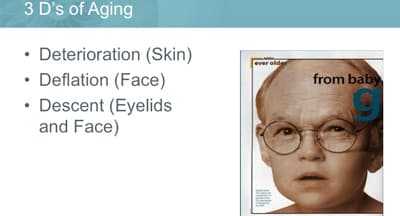Our faces are critical in how we communicate with the outside world. Often with age, our faces change in ways that effect how others treat us. Our faces can make us look mad, tired, sick or sad, even when we feel fine inside.
Is there a way to evaluate how our faces age? Is there an easy key to understanding the facial aging process?
When I evaluate a patient’s face, I often analyze what I call the 3 D’s of Aging:
- Skin Deterioration
- Facial Deflation
- Facial Descent
Skin Deterioration describes the appearance of facial skin over time and is often related to past sun exposure. An irregular skin complexion can make us appear older and less healthy to others.
Facial Deflation is due to normal aging changes in our face where certain deeper facial structures change over time, such as the fat pads, bones and teeth in our face. Loss of the normal volume of youth over time makes us look older and less vibrant to others.
Facial Descent often follows loss of facial volume and describes the falling of our eyelids, eyebrows and jowl formation as we age. It’s like a tulip that, when young and full of water, stands up; but as the water leaves the tulip, it droops. There isn’t more gravity acting on the tulip; it’s just that it’s lost its healthy volume. Our faces act the same way. This also makes us look older and less vibrant to others.
Thankfully, there are effective, quick options to help improve the 3 D’s of Aging, allowing my patients to reclaim their natural beauty in a younger, healthier and more attractive state. If you want to learn more about this topic, visit my blog Facial Rejuvenation to Facial Transplant: The Spectrum.
I hope you found this interesting, and I invite you come back and watch again for our next Medical Minute. Goodbye for now, and I wish each of you a beautiful day.
